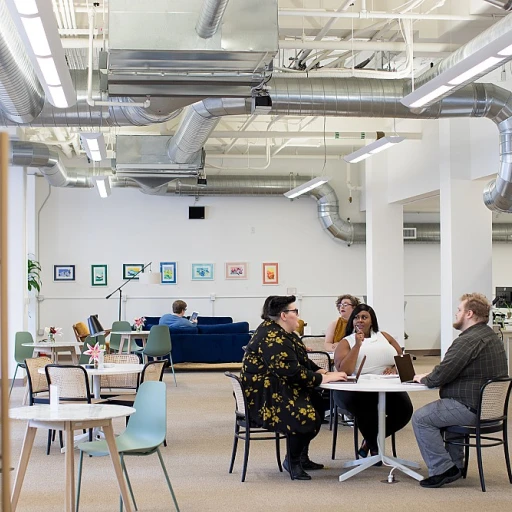
Understanding the Skills Gap
Grasping the Concept of Skills Gap
In today's fast-paced work environment, the term "skills gap" is thrown around quite a bit. But what does it really mean? Simply put, it's the difference between the skills that employers need and the skills that employees actually possess. This gap can leave businesses struggling to find the right talent, and employees feeling a bit lost or overwhelmed.
Why does this matter? Well, when there's a mismatch in skills, it affects productivity, employee morale, and even the bottom line. Organizations may find themselves unable to keep up with industry demands, while employees might feel stuck, unable to progress in their careers. The good news is, with the right strategies, this gap can be closed, leading to a more engaged and productive workforce.
Real-Life Impact of Skill Gaps
Consider a tech company that's on the cutting edge of innovation. They need employees who are not only tech-savvy but also possess strong soft skills like communication and teamwork. However, if their current workforce lacks these skills, the company might struggle to bring new products to market or collaborate effectively. This scenario isn't just hypothetical; it's happening in businesses across various industries.
According to a recent study, nearly 75% of employers report difficulty in finding candidates with the right skills. This gap isn't just about technical abilities; it also includes soft skills, which are increasingly vital in today's collaborative work settings.
Why the Skills Gap is Growing
Several factors contribute to the widening skills gap. Rapid technological advancements mean that the skills required today may not be the same as those needed tomorrow. Additionally, many educational systems are struggling to keep pace with these changes, leaving graduates unprepared for the current job market.
Moreover, businesses themselves may not always prioritize employee development, leading to stagnation. This lack of focus on continuous learning and development can leave employees feeling disengaged and undervalued.
Addressing these challenges requires a comprehensive approach, involving targeted training programs, leveraging technology for skill enhancement, and fostering a culture of continuous learning. As we explore further, we'll see how organizations can effectively bridge this gap and boost employee engagement.
The Role of Employee Engagement
The Impact of Engaged Employees on Business Success
A thriving business often comes down to having a team of engaged employees who genuinely care about their work. Engaged employees are more productive, produce higher quality work, and are more likely to stick around, reducing turnover costs. But how exactly do we improve this engagement? It starts with understanding the skills gap. Employee engagement isn't just about keeping people happy or satisfied. It's about creating an environment where each employee feels they're making meaningful contributions. It may sound simple, but it requires active management and a deep understanding of the individual and collective skills gaps within a team or organization.The Connection Between Skills and Engagement
When employees have confidence in their skills and feel adept at completing tasks, they're more likely to be engaged. Consider a worker who regularly encounters tasks for which they lack skills. Their frustration will likely lead to disengagement over time. A properly aligned skill development plan, on the other hand, can empower employees to take ownership of their personal growth, weaving skill-gap solutions into the fabric of teamwork and daily performance. However, bridging the skills gap also means recognizing and celebrating different types of talent within your workforce. It requires fostering an appreciation for soft skills as much as technical skills, understanding that communication, empathy, and adaptability are equally crucial in keeping employees engaged and motivated.Boosting Employee Engagement Through Learning Development
One effective way to boost engagement is investing in continuous learning and development opportunities. When employers invest in their employees' skill growth, both parties benefit immensely. Training and development not only close skill gaps but also signal to employees that they're valued and that their career progression's being taken seriously. By prioritizing ongoing training sessions, workshops, and mentorship programs, businesses can spark employee engagement and build a learning culture. Providing skills training that is flexible and accessible, even in hybrid or remote work settings, can further enhance employees' experiences. As this effort to upskill and reskill workers continues, organizations must also employ effective gap analysis techniques to regularly assess skills gaps and adjust learning strategies as necessary. You can find more details on effective gap analysis techniques and strategies in this insightful blog post about the IT skills gap.Identifying Skill Deficiencies
Pinpointing Where Employees Need to Grow
It's like assembling a jigsaw puzzle—you can’t make the whole picture clear without knowing what pieces are missing. In the world of skills and talent, this involves recognizing where your employees lack skills. A good place to begin is with a solid gap analysis, which digs into what your workforce knows versus what they need to know. Identifying these skill shortages requires a mix of management insight, employee feedback, and perhaps a bit of work with data. Evaluation tools can be a great help here—surveying both hard and soft skills to get a comprehensive view not only of individual capabilities but the team as a whole. An understanding not only stops with knowing current gaps, it also gives foresight into potential future skills gaps that might arise as your business evolves. Oh, and don't forget the power of personal stories in this area. Talk with employees, learn what skills they wish to develop or have struggled with in the past. Remember, sometimes the insights you need are right under your nose, waiting to be found in everyday conversations. Consider internal mobility as a key to your employee development puzzle. Sometimes closing skills gaps isn’t about bringing in new talent but about moving current employees into roles where they're keen to grow and learn. If Jane from accounting shows a knack and interest in project management, why not support her with training and a transition?” For more inspiration about addressing skill gaps, explore bridging the leadership skills gap.Training and Development Solutions
Boosting Employee Skills Through Effective Training
When it comes to closing skills gaps, training and development are your best friends. Think about it: employees who lack skills often feel disconnected, and that’s a recipe for low engagement. But with the right training, you can turn that around.
Imagine Jane, a dedicated employee in your organization. She's great at her job but feels there's a gap in her skill set that’s holding her back. By offering her targeted learning development opportunities, you not only help her grow but also boost her morale and engagement.
Here are a few ways to make training work for your business:
- Customized Training Programs: Identify specific skill gaps through a detailed gap analysis and tailor training to meet those needs. Personalized learning paths make employees feel valued and understood.
- On-the-Job Training: This hands-on approach allows employees to learn while they work, making the process practical and immediately applicable.
- Soft Skills Development: Don’t overlook the importance of soft skills like communication and teamwork. They’re crucial for employee experience and engagement.
- Internal Mobility: Encourage employees to move within the company. This not only fills skill gaps but also enriches the talent pool.
Training isn’t just about filling a skills gap. It’s about creating a culture of continuous learning and development, where employees feel they’re growing and contributing to the organization’s success. Remember, a well-trained workforce is a happy workforce.
So, what's your next move? Consider booking a demo with a training provider to explore how you can implement these strategies effectively. It’s a step that will pay dividends in employee engagement and business growth.
Leveraging Technology for Skill Enhancement
Boosting Skills with Tech
In the hustle and bustle of today’s work environment, technology isn’t just a tool—it’s a game-changer. When it comes to closing skills gaps, tech offers a helping hand to businesses and employees alike. Think of it as a bridge, connecting the skills employees have to the ones they need.
Take online learning platforms, for instance. These platforms provide access to a treasure trove of resources, allowing employees to learn at their own pace. Whether it’s brushing up on soft skills or diving into technical know-how, these platforms offer something for everyone. And let’s not forget about webinars and virtual workshops—they’re like having a personal tutor right at your fingertips.
Data: The Unsung Hero
Data is the unsung hero in this story. With proper analysis, businesses can pinpoint skill gaps with laser precision. It’s like having a map that guides you to the exact spot where training is needed. This not only saves time but also ensures that employee development is on point.
Moreover, AI-driven tools are making waves in talent management. They help in personalizing learning experiences, ensuring that each employee gets the training that suits their needs. It’s all about making learning as effective and engaging as possible.
Embracing Internal Mobility
Internal mobility is another ace up the sleeve for organizations. By using tech to track employee skills and career aspirations, businesses can fill roles internally. This not only boosts employee engagement but also saves on recruitment costs. Employees feel valued and are more likely to stick around, knowing that their career growth is a priority.
However, it’s not all sunshine and rainbows. Privacy concerns can pop up, especially with data collection. It’s crucial for businesses to have a solid privacy policy in place, ensuring that employee data is handled with care.
In the end, leveraging technology for skill enhancement is all about balance. It’s about using the right tools to support employee development while keeping an eye on privacy and mental health. With the right approach, businesses can not only close skills gaps but also create a thriving workforce.
Measuring Success and Adjusting Strategies
Success Measurement and Strategy Tweaks
It's the million-dollar question: How do you know if your skill gap strategies are working wonders or missing the mark? Well, it's not magic, it's metrics. Tracking results helps you figure out what's getting folks jazzed and what's leaving them in the dust. Think about it, when skills training and development programs roll out, observing changes in workforce performance becomes essential. Increased productivity, employee satisfaction, and a proven lift in engagement levels are good indicators you're on the money. Managers might see folks being able to tackle more complex tasks without breaking a sweat. Consider these when measuring the success of your initiatives:- Employee Feedback: Your team knows best. They’re on the frontlines, engaging with these programs firsthand. Use surveys or informal chats to hear what’s hitting the spot or falling flat.
- Performance Metrics: Numbers don't lie! Check if there's a bump in output or quality following training.
- Retention Rates: It's simple—a more engaged employee sticks around, meaning lower turnover.












